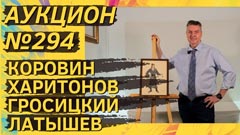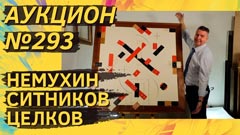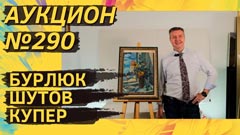
MASTERPIECES
KRASNOPEVTSEV Dmitry Mikhailovich (1995) Cracked vessels with fallen out parts. 1963. Oil on hardboard. 53 × 61
In the guidebook of Alexander Ushakov, the custodian of the Krasnopevtsev archive and the main connoisseur of his art, on page 55 there is a black and white photo. It says: “Cracked vessels with fallen out parts. 1963. No size. Collection of the family of G. Costakis, Athens”.
We'll fix the “no size” thing right now. The size is 53 × 61. In confirmation of the provenance in the photo with this painting stands Elena Dymova (sometimes spelled Dimova) — granddaughter of Costakis, daughter of Inna Georgievna Costakis-Dymova.
Krasnopevtsev was one of the few favorite artists of “Uncle Zhora”. The caretaker of the Canadian embassy, with Greek citizenship, Costakis became one of the key figures in the history of Russian art. He essentially saved many works of the Russian avant-garde and helped preserve for history our second avant-garde, the 1960s artists. Costakis bought one or two paintings a year from Krasnopevtsev. This is an exemplary work in front of us. After all, 1963 is the beginning of Krasnopevtsev's most valuable period. Approximately 500 paintings belong to that period. And according to my estimates, there are no more than 50 works of comparable size and quality.
The master of metaphysical still life, Dmitry Krasnopevtsev, is today one of the most expensive artists of unofficial art. His auction record at the peak of the market was almost a million dollars. The philosophical basis of Krasnopevtsev's metaphysical still lifes is the idea of the frailty of the world and the desire for natural harmony, embodied in the equilibrium without symmetry. Krasnopevtsev worked for 20 years as an artist for Reklamfilm. He didn't fall into the trough of socialist realism, but even under Soviet rule he was quite successful. His paintings were bought by diplomats, foreigners and a few of our collectors. It is known that Krasnopevtsev was a Francophile. He dreamed of going to France and was preparing for it. I read that in his studio hung a century-old city plan of Paris, which he learned by heart. Street names, the location of museums — everything not to get lost in the beloved city. But he was never allowed abroad. A successful, wealthy artist, he died without ever having seen France. It was a common occurrence at the time. I tell this for young people who want to go to the USSR for some reason.
PIVOVAROV Viktor Dmitrievich (1937) Meeting. 2020. Canvas, acrylic. 70 × 65
Viktor Pivovarov is one of the main representatives of Moscow conceptualism. It is one of our few inventions that has enriched the world history of fine art. In the 1960s, Pivovarov was a member of the so-called “Sretensky Boulevard Group”, which included Ilya Kabakov, Ülo Sooster, Vladimir Yankilevsky, writer Vladimir Sorokin and others. The artist made a living as a book designer. Who doesn't know: Pivovarov is the author of the logo for children's magazine “Funny Pictures”, which was published in millions of copies. That was the official life, and there was a second, unofficial life. No permitted exhibitions, only for his own people, bold and innovative art.
This painting is the first part of a logical diptych. In addition to this “Meeting”, we also have “Parting”. Although they are sold one at a time. Both canvases are from 2020. New. But on old classic themes. Those that are especially sought after by collectors. However, Pivovarov, according to reviews, not much has changed. He is still the same merry man, mocker and wit.
1960s UNOFFICIAL ART
ZVEREV Anatoly Timofeevich (1931–1986) Spontaneous composition. 1959. Paper, whitewash, scratching. 54 × 34
A rare early 1950s Zverev from the Costakis collection. That's what Valery Silaev notes in his expertise. Such pieces were dispersed among collections, the mass of them were exported abroad. Expressive Tashist composition. Written in one go. Museum value.
KROPIVNITSKY Lev Evgenievich (1922–1994) Tablets. 1990. Oil on canvas. 178 × 91
It was impossible to send photos from the camp to a convict. But someone who could draw could make a self-portrait for his parents. Lev Kropivnitsky did so. But the camp censor said: “You're naughty”. Too sad, make it more cheerful, otherwise we will not allow it. And then Kropivnitsky drew on a tie. Now it was a different story!
It was in 1946 or later. A young student of the Institute of Decorative and Applied Arts, yesterday's front-line soldier and disabled war veteran (after a second serious wound he spent a year in the hospital) was sent to the camp on the same case as Sveshnikov — for “organizing an attempt on Stalin's life”. 10 years on trumped-up charges. He came back to Moscow in 1956. As he himself said, at 34 he started his life anew. He came to his father and mother in Lianozovo. And everyone knows this family. Lev Kropivnitsky's father is Evgeny Kropivnitsky, “Grandfather”, founder of the “Lianozovo Group”, and father-in-law of Oskar Rabin.
Lev Kropivnitsky was a participant of apartment exhibitions. In the mid-1970s, he exhibited at the City Graphic Arts Committee on Malaya Gruzinskaya Street and worked in magazine illustration. He is remembered as an abstractionist. The large absurdist canvases with a figurative base are more like Kropivnitsky's paintings of the 1980s. Why “Tablets”? That's where we have to think together. The tablets, as we remember, are the plates with the Ten Commandments given to Moses on Mount Sinai. The character in the painting is also holding a tablet with the writings. But it will be a task for the new owner to find out which parallels the artist drew.
ZHDANOV Alexander Pavlovich (1938–2006) Okay! 2002. Oil on cardboard. 88 × 97
Interesting work and a new name for us. Alexander Zhdanov is a man of the sixties, a nonconformist who left for the United States. We have heard the name, but never sold his works. And now...
The base is similar to linoleum. But it's cardboard filled with bitumen, boustylate, or enamel. That's what Zhdanov did back in the 1960s, when he was a student at a college in Rostov. While everyone was learning the basics of Socialist Realism, Zhdanov, as they say, “looked under his feet” and used trash materials to create abstractions. He filled scraps, wrappers and cigarette butts with glue, and very interesting things came out. Later it became known as combined painting. And Zhdanov himself called his compositions “trash bins”.
Classmates noted Zhdanov's phenomenal sense of color and harmony. He was famous for his ability to enliven a hopeless picture of his student friend with just one correct stroke. Zhdanov was forced to leave by family circumstances. In 1982 his stepdaughter, Vassa Gerasimova, a member of the USSR synchronized swimming team, ran away from a hotel in Spain and sought asylum in the USA. This came as a surprise to the family. Zhdanov and the girl's mother, Galina Gerasimova, appealed to the authorities to leave for their daughter, but was refused. The wife was kicked out of her job at a scientific institute and went to work as a janitor. This went on for five years until he and his wife chained themselves in front of the gates of the American embassy. After that, they were given permission to leave for a family reunion. Zhdanov died in America in 2006. His works were exhibited at the “Other Art” exhibition at the Tretyakov Gallery. Today they are represented in the leading museums of the country, in the American Zimmerli (Norton Dodge collection) and in private collections.
NEY Alexander (1939) Happy Days. 2010. Acrylic on canvas. 122 × 152.5
We are used to Ney the sculptor. And today we're going to meet a painting. But this is the recognizable Ney — his whimsical knitting of circle patterns, laconic geometry, and pleasing subject matter. “Happy Days”. Alexander Nezhdanov (Ney is his American pseudonym) graduated from the sculpture department of the Repin Institute in Leningrad. He was friends with Chemiakine. Worked as an art restorer in the Hermitage. Made sets at Lenfilm, including for Kozintsev's King Lear.
After emigrating to the United States in 1972, he worked with the Nakhamkin and Mimi Ferzt galleries. In the 2010s, Alexander Ney's exhibitions were held at leading venues in Russia, including the State Center for Contemporary Art, the Museum of Decorative and Applied Art, and others.
CHEMIAKINE Mikhail Mikhailovich (1943) Cook and Baby-Rat Pilferer. 2021. Sculpture. Pewter alloy, tempera, acrylic. Height 9 cm
Before us is a stirring scene from Hoffmann's fairy tale “The Nutcracker”. Chemiakine did the sets and costumes for the 2001 ballet at the Mariinsky Theater. And so an edition of pewter sculptures painted in tempera and acrylic was made based on that project. The sculpture is sold with a certificate from the Chemiakine Foundation.
The author needs no introduction. Chemiakine is a world star and the pride of Russian art. That's now. But 60 years ago, in the USSR, the authorities considered him a dauber artist with a bad temper and a lunatic asylum. In 1961 he was expelled from the Repin Institute for “not corresponding to the norms of socialist realism art worldview” and “aesthetic corruption of fellow students”. In 1964, “The exhibition of artists-workers of the Economic Section of the Hermitage. Toward the Hermitage's 200th Anniversary”, in which he took part along with Vladimir Ovchinnikov and others, was closed one day after opening with scandal. The Hermitage director was fired. And Chemiakine received a “wolf ticket”. He had no chance to participate in exhibitions. The artist who developed a system of metaphysical synthetism made a living as a loader in the USSR. After six years of suffering he managed to emigrate to France. In pursuit of him, he was deprived of Soviet citizenship.
CONTEMPORARY ART
SAVKO Alexander Andreevich (1957) Unforgettable meeting. 2007. Acrylic on canvas. 140 × 200
We could talk about this picture for two hours — it's just a tangle of stories. That's why we describe in the theses.
- The author Alexander Savko uses the technique of palimpsest, a reworking of the plots of well-known works. The peculiarity of his palimpsests is the absurdist reinterpretation of classics, often humorous.
- In 2011 his humor took him to court on extremism charges. Savko's work “The Sermon on the Mount” from the series “Mickey Mouse's Travels in Art History” (which combined images of Mickey's head and Jesus from an engraving by Julius Schnorr von Karolsfeld) was declared extremist by the Tarusa court. According to expert examinations, Savko's work contained graphic information calling for extremist activities, in particular, propagandizing the inferiority of a person on the basis of his religious affiliation or attitude toward religion, in this case, Orthodox believers.
- And now we have Stalin with the face of a sheepdog, so we don't know what to think. Before us is a palimpsest of a painting by the Stalin Prize laureate Vasily Efanov with the long title “Unforgettable Meeting (Party and Government Leaders in the Presidium of the All-Union Meeting of Wives of Business Executives and Engineering and Technical Workers of Heavy Industry in the Kremlin)”. It was presented in 1939, when some of the participants of that meeting were no longer alive.
- The dogs look at the cats carnivorously for a reason. In the original, Stalin is applauded by the customer of this painting, Sergo Ordzhonikidze. He suggested to the artist to depict the meeting of non-working wives of functionaries with Stalin, which took place in 1936. Until 1937, a revolutionary of noble birth, Ordzhonikidze was the People's Commissar of Heavy Industry. In 1937 he shot himself. He did not wait to be arrested. Shortly before that, Beria had arrested and shot his beloved older brother. Sergo's wife, who is pictured to his right, was exiled to the camps for 10 years after her husband's death. Almost the entire family was repressed and some were shot. Behind Stalin is Nikita Khrushchev, who would debunk the cult of personality. And next to him is Klim Voroshilov, who would sign the death sentences of nearly twenty thousand Red Army officers. Such an unforgettable meeting.
- The painting by Savko is huge. 2 meters. But Efanov's original at the Tretyakov Gallery is four times as big, almost 4 meters wide. You can imagine.
- Efanov was called “the founder of applause realism”. He received all his five Stalin Prizes for scenes from the life of leaders and cultural figures. For example, for the painting “I. V. Stalin, K. E. Voroshilov, V. M. Molotov at the bedside of the sick A. M. Gorky”.
- Interestingly, Efanov once played an important role in the fate of the artist Viktor Kazarin. He stood up for Kazarin during the defense of his diploma. Kazarin graduated from the Art and Graphic Department of the Lenin Pedagogical Institute in 1971. At his graduation exhibition, Kazarin's painting “Man and Flowers” was not liked by his superiors, they called it anti-art and made it clear that he was threatened with an F. I quote further, as Kazarin recounted it: “They wanted to expel me. But then Efanov (the highest authority) said to my teacher Dreznina: "If you refuse him, then I'll take". And then she enlisted his support, that Efanov would come to the defense. And he got a toothache. And he did not come to the beginning. And then those professors started turning against me. The sculptor Pisarevsky and others. One of them says: "Where's the color here? I only see blackness!" And then Efanov comes in, all bandaged, hears these words, and interrupts him: "What blackness?! I see color here!" And he tells them all off one by one and sits them down. And they smile like schoolboys and sit down. I stand — I like it. Efanov kept his word. They gave a B. Then he tells Dreznina: "You know, they couldn't give you an A"”.
Such an “Unforgettable meeting”.
- Log in to post comments










